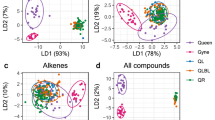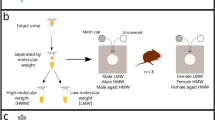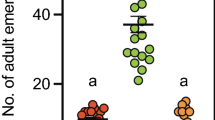Mood-altering secretions by excited male elephants smooth out social interactions.
Abstract
Male Asian elephants in musth — an annual period of heightened sexual activity and intensified aggression — broadcast odoriferous, behaviourally influential messages from secretions of the temporal gland1,2,3,4. From our observations in the wild, together with instantaneous chemical sampling and captive-elephant playback experiments, we have discovered that young, socially immature males in musth signal their naivety by releasing honey-like odours to avoid conflict with adult males, whereas older musth males broadcast malodorous combinations to deter young males, facilitating the smooth functioning of male society. As elephant–human conflicts can upset this equilibrium, chemically modulating male behaviour may be one way to help the conservation of wild elephants.
This is a preview of subscription content, access via your institution
Access options
Subscribe to this journal
Receive 51 print issues and online access
$199.00 per year
only $3.90 per issue
Buy this article
- Purchase on Springer Link
- Instant access to full article PDF
Prices may be subject to local taxes which are calculated during checkout

L. E. L. RASMUSSEN
Similar content being viewed by others
References
Jainudeen, M. R., McKay, G. M. & Eisenberg, J. G. Mammalia 36, 247–261 (1972).
McKay, G. M. Smithson. Contr. Zool. 125, 1–113 (1973).
Rasmussen, L. E. L. & Perrin, T. E. Physiol. Behav. 67, 539–549 (1999).
Rasmussen, L. E. L. Ecoscience 5, 410–426 (1998).
Edgerton, F. The Elephant-Lore of the Hindus (Motilal Banarsidass, Delhi, 1931).
Chandrasekharan, K. et al. in The Asian Elephant: Ecology, Biology, Disease, Conservation and Management (eds Silas, E., Nair, M. & Nirmalan, G.) 71–74 (Kerala Agric. Univ., India, 1992).
Arthur, C. L. & Pawliszyn, J. Anal. Chem. 62, 2145–2148 (1990).
Perrin, T. E., Rasmussen, L. E. L., Gunawardena, R. & Rasmussen, R. A. J. Chem. Ecol. 21, 207–221 (1996).
Free, J. B. Pheromones of Social Bees (Chapman & Hall, London, 1987).
Francke, W. et al. J. Chem. Ecol. 21, 1043–1064 (1995).
Phillips, T. W., Nation, J. L., Wilkinson, R. C. & Foltz, J. L. J. Chem. Ecol. 15, 1513–1533 (1989).
Krishnan, M. J. Bombay Nat. Hist. Soc. 69, 298–315 (1972).
Sukumar, R. The Asian Elephant: Ecology and Management (Cambridge Univ. Press, Cambridge, 1989).
Author information
Authors and Affiliations
Corresponding author
Supplementary information
Rights and permissions
About this article
Cite this article
Rasmussen, L., Riddle, H. & Krishnamurthy, V. Mellifluous matures to malodorous in musth. Nature 415, 975–976 (2002). https://doi.org/10.1038/415975a
Issue Date:
DOI: https://doi.org/10.1038/415975a
This article is cited by
-
Brown bear skin-borne secretions display evidence of individuality and age-sex variation
Scientific Reports (2023)
-
An odorant-binding protein in the elephant's trunk is finely tuned to sex pheromone (Z)-7-dodecenyl acetate
Scientific Reports (2022)
-
Male and female developmental differences in chemosensory investigations by African elephants (Loxodonta africana) approaching waterholes
Behavioral Ecology and Sociobiology (2010)
-
Responses of immature male masu salmon parr to the urine of mature males
Ichthyological Research (2006)
-
Chirality in elephant pheromones
Nature (2005)
Comments
By submitting a comment you agree to abide by our Terms and Community Guidelines. If you find something abusive or that does not comply with our terms or guidelines please flag it as inappropriate.



